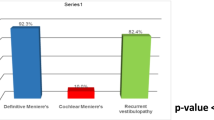Summary
Twenty-four patients with acute low-tone sensorineural hearing loss (ALHL) were examined using electrocochleography. The negative summating potential (SP) amplitude and the summating potential/action potential (AP) ratio were significantly greater in the ALHL patients than in normals. The SP/AP ratio was smaller in the ALHL patients than in patients with known Meniere's disease and moderate hearing loss, although the SP amplitude was somewhat greater in the former. An abnormal increase in the SP amplitude following click stimuli was found in 54% of the ALHL patients, while the SP/AP ratio was increased abnormally in 63% of these patients. These findings suggest that the pathophysiology of ALHL may be similar to that for endolymphatic hydrops.
Similar content being viewed by others
References
Abe T (1982) Acute sensorineural hearing loss in low frequencies (in Japanese). Otolaryngol (Tokyo) 54:385–392
Abe T, Kon Y, Murai K, Tuiki T (1988) Clinical picture of low tone sudden deafness (in Japanese). Jpn J Otolaryngol 91:667–676
Aso S, Watanabe Y, Mizukoshi K (1991) A clinical study of electrocochleography in Meniere's disease. Acta Otolaryngol (Stockh) 111:44–52
Coats AC (1981) The summating potential and Meniere's disease. I. Summating potential amplitude in Meniere and nonMeniere ears. Arch Otolaryngol Head Neck Surg 107:199–208
Dallos P, Cheatham MA (1976) Production of cochlear potentials by inner and outer hair cells. J Acoust Soc Am 60:510–512
Durrant JD, Gans D (1975) Biasing of the summating potentials. Acta Otolaryngol (Stockh) 80:13–18
Eggermont JJ (1979) Summating potential in Meniere's disease. Arch Otorhinolaryngol 222:63–75
Enander A, Stahle J (1967) Hearing in Meniere's disease. A study of pure-tone audiograms in 334 patients. Acta Otolaryngol (Stockh) 64:543–556
Gibson WPR, Prusher DK, Kilheng GPS (1983) Diagnostic significance of transtympanic electrocochleography in Meniere's disease. Ann Otol Rhinol Laryngol 92:155–159
Goin DW, Staller SJ, Asher DJ, Mischke RE (1982) Summating potential in Meniere's disease. Laryngoscope 92:1383–1389
Hallberg OE (1956) Sudden deafness of obscure origin. Laryngoscope 66:1237–1267
Mori N, Asai H, Doi K, Matsunaga T (1987) Diagnostic value of extratympanic electrocochleography in Meniere's disease. Audiology 26:103–110
Ohashi T, Takeyama I (1989) Clinical significance of SP/AP ratio in inner ear diseases. ORL 51:235–245
Parving A, Bak-Pedersen K (1978) Clinical findings and diagnostic problems in sensorineural low frequency hearing loss. Acta Otolaryngol (Stockh) 85:184–190
Yamasoba T, Sugasawa M, Yagi M, Harada T, Futaki T (1990) Clinical observation of acute low-tone sensorineural hearing loss considered as cochlear hydrops (in Japanese). Jpn J Otolaryngol 95:41–50
Walsh TE (1958) Meniere's disease. Laryngoscope 68:279–287
Author information
Authors and Affiliations
Rights and permissions
About this article
Cite this article
Yamasoba, T., Sugasawa, M., Kikuchi, S. et al. An electrocochleographic study of acute low-tone sensorineural hearing loss. Eur Arch Otorhinolaryngol 250, 418–422 (1993). https://doi.org/10.1007/BF00180389
Received:
Accepted:
Issue Date:
DOI: https://doi.org/10.1007/BF00180389




